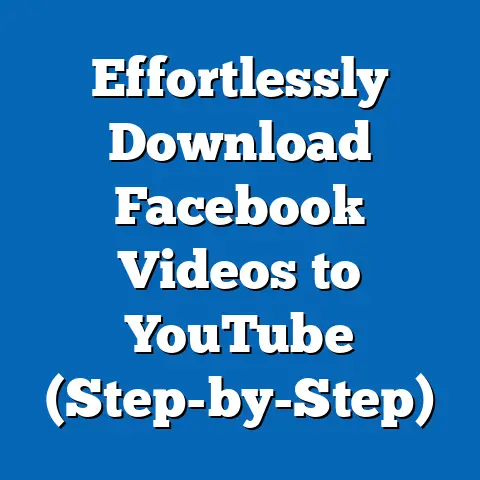Mastering Delivery Facebook Ads (Unlock Proven Strategies)
Political advertising has undergone a profound transformation, with platforms like Facebook becoming central arenas for shaping public opinion and mobilizing voters. The concept of “modern aesthetics” in political advertising refers to a sophisticated blend of visual, emotional, and data-driven strategies designed to resonate with specific demographic groups. This article explores the intersection of modern aesthetics with political messaging, focusing on how “Mastering Delivery Facebook Ads (Unlock Proven Strategies)”—a framework for optimizing ad performance—reflects broader trends in political communication.
Modern aesthetics in political ads are characterized by highly targeted, visually engaging content that leverages psychological triggers, cultural symbols, and demographic data to influence voter behavior. These strategies are not merely technical but are deeply tied to the identity, values, and priorities of the audiences they aim to reach. By examining the demographic makeup, core beliefs, voting patterns, and distinguishing characteristics of groups targeted by such ads, we can better understand their impact on contemporary political landscapes.
Defining Modern Aesthetics in Political Advertising
Demographic Composition of Target Audiences
Modern aesthetics in political advertising are often tailored to specific demographic segments, leveraging Facebook’s robust data analytics to target users based on age, gender, location, education, and interests. According to a 2021 Pew Research Center report, 70% of U.S. adults use Facebook, with usage particularly high among adults aged 18-29 (81%) and 30-49 (78%). This platform’s dominance among younger and middle-aged demographics makes it a critical tool for campaigns aiming to influence these groups.
Racial and ethnic diversity also plays a significant role in shaping ad aesthetics. For instance, Black and Hispanic Americans are more likely to engage with political content on social media, with 64% of Black adults and 59% of Hispanic adults reporting that they encounter political posts frequently, compared to 54% of White adults (Pew Research, 2020). Campaigns using modern aesthetics often tailor imagery, language, and cultural references to resonate with these communities.
Education levels further influence how ads are crafted. College-educated users tend to respond to policy-heavy content with data and statistics, while those with lower educational attainment often engage more with emotionally charged or narrative-driven ads (American National Election Studies, 2020). Understanding these demographic nuances is central to the “Mastering Delivery” framework, which emphasizes hyper-personalized content delivery.
Core Beliefs and Values Reflected in Modern Aesthetics
Modern aesthetics in political ads often reflect the values of individualism, authenticity, and immediacy, aligning with the cultural zeitgeist of the digital era. These ads prioritize relatability over traditional authority, often featuring real people rather than polished politicians, a trend supported by a 2022 Edelman Trust Barometer finding that 63% of Americans trust “people like me” over traditional leaders. This shift underscores a broader societal move toward peer-driven influence, which modern aesthetics exploit through user-generated content styles.
Additionally, these ads often emphasize urgency and personal impact, tapping into core beliefs about self-efficacy and community empowerment. For instance, climate change ads targeting younger demographics frequently frame the issue as a personal moral responsibility, with 73% of Gen Z and Millennials expressing concern about environmental issues in a 2021 Gallup poll. The “Mastering Delivery” approach amplifies these values by using emotive visuals and concise calls-to-action to drive engagement.
Voting Patterns and Political Engagement
The effectiveness of modern aesthetics in political ads is evident in their impact on voting patterns and engagement, particularly among younger demographics. A 2020 study by the Center for Information and Research on Civic Learning and Engagement (CIRCLE) found that 67% of 18-29-year-olds voted in the 2020 U.S. presidential election, a significant increase from 46% in 2016, with many citing social media as a key source of political information. Targeted Facebook ads, designed with modern aesthetics, played a pivotal role in this mobilization, often using vibrant visuals and interactive elements to encourage voter registration and turnout.
Engagement patterns also vary by political affiliation. Democrats are more likely to interact with ads focusing on social justice and healthcare, while Republicans often engage with content emphasizing economic freedom and national security, according to a 2021 YouGov survey. The “Mastering Delivery” framework capitalizes on these differences by segmenting audiences and delivering tailored aesthetic experiences that align with partisan priorities.
Policy Positions on Major Issues
Modern aesthetics in political ads often reflect specific policy positions, using visual and narrative strategies to frame issues in ways that resonate with target audiences. For instance, ads on healthcare reform frequently use imagery of families and personal stories to evoke empathy, with 62% of Americans citing healthcare as a top concern in a 2022 Kaiser Family Foundation poll. These ads often align with progressive calls for universal coverage among younger and urban demographics.
On economic issues, ads targeting working-class voters may employ rugged, industrial imagery to underscore themes of job creation and wage growth, reflecting conservative or populist policy priorities. A 2021 Bureau of Labor Statistics report notes that 58% of non-college-educated workers prioritize economic stability in political messaging, a trend that modern aesthetics exploit through relatable, grounded visuals. The “Mastering Delivery” framework optimizes these policy-focused ads by testing multiple aesthetic variations to identify the most impactful delivery.
Distinguishing Features from Other Political Messaging Groups
Unlike traditional political advertising, which often relies on broad, one-size-fits-all messaging through television or print, modern aesthetics prioritize micro-targeting and visual storytelling. Traditional ads, for instance, reached 85% of households via TV in the 1990s (Nielsen, 1995), but lacked the precision to tailor content to individual preferences. In contrast, Facebook ads using modern aesthetics can target users based on specific behaviors, with 91% of advertisers reporting improved ROI through personalized content (Facebook Business Insights, 2022).
Another distinguishing feature is the emphasis on virality and shareability. Modern aesthetics incorporate memes, short videos, and interactive polls to encourage organic distribution, a strategy absent in older, static ad formats. This aligns with the “Mastering Delivery” focus on maximizing engagement through iterative testing and real-time feedback loops.
Comparative Analysis with Other Political Messaging Strategies
Traditional Political Advertising
Traditional political advertising, predominantly through television and radio, focuses on mass appeal and often lacks the granular targeting of modern aesthetics. While effective in reaching older demographics—76% of adults over 65 still rely on TV for political news (Pew Research, 2021)—these ads struggle to engage younger voters who spend an average of 2.5 hours daily on social media (Statista, 2022). Modern aesthetics, by contrast, thrive in this digital space, using platforms like Facebook to deliver personalized content with immediate feedback mechanisms.
Traditional ads also tend to prioritize long-form messaging, with 30-second or 60-second spots detailing policy platforms. Modern aesthetics, as seen in the “Mastering Delivery” framework, favor brevity and emotional impact, often condensing complex issues into 10-second clips or single images that evoke strong reactions. This shift reflects broader cultural trends toward shorter attention spans and instant gratification.
Grassroots and Activist Messaging
Grassroots and activist messaging, often disseminated through community organizing and word-of-mouth, shares some similarities with modern aesthetics, particularly in emphasizing authenticity and personal connection. However, grassroots efforts typically lack the technological sophistication and data-driven targeting of modern aesthetics, relying instead on broad ideological appeals. For example, while 68% of grassroots campaign volunteers cite face-to-face interaction as their primary outreach method (American National Election Studies, 2020), modern aesthetics leverage algorithms to reach millions with pinpoint accuracy.
Grassroots messaging also tends to be less visually polished, focusing on raw, unfiltered content that may not appeal to broader audiences. Modern aesthetics, through frameworks like “Mastering Delivery,” balance authenticity with professional design, ensuring ads are both relatable and visually compelling. This hybrid approach often yields higher engagement rates, with targeted Facebook ads achieving click-through rates of 1.2% compared to 0.5% for untargeted content (WordStream, 2022).
Intersections of Modern Aesthetics with Demographic Factors
Age and Generational Differences
Age significantly influences how modern aesthetics are received, with younger generations (Gen Z and Millennials) showing greater responsiveness to digital-first strategies. A 2021 Deloitte survey found that 84% of Gen Z consumers trust brands that use authentic, user-generated content, a cornerstone of modern aesthetics in political ads. Older generations, such as Baby Boomers, are more likely to engage with ads that mimic traditional formats, even on digital platforms, with 61% preferring straightforward messaging over trendy visuals (Nielsen, 2021).
These generational divides necessitate varied aesthetic approaches within the “Mastering Delivery” framework. For younger audiences, ads may incorporate memes, bold colors, and fast-paced editing, while ads for older demographics might use calmer visuals and direct language. This segmentation ensures maximum resonance across age groups.
Education and Socioeconomic Status
Education and socioeconomic status also shape the reception of modern aesthetics. Higher-educated individuals often engage with ads that present detailed policy arguments or data visualizations, with 55% of college graduates citing factual accuracy as a key trust factor (Pew Research, 2020). Conversely, those with lower educational attainment or income levels respond more to emotional narratives, with 67% of high school-educated adults prioritizing personal stories in political content (American National Election Studies, 2020).
Socioeconomic status further influences aesthetic preferences, as lower-income audiences often prioritize immediate, tangible benefits in messaging, such as job opportunities or healthcare access. Modern aesthetics adapt to these needs through targeted imagery and language, a strategy central to the “Mastering Delivery” approach, which uses A/B testing to refine content for specific socioeconomic segments.
Race, Ethnicity, and Cultural Identity
Racial and ethnic identities play a critical role in shaping the design and impact of modern aesthetics in political ads. Black and Hispanic communities, for instance, are more likely to engage with content that reflects cultural symbols and addresses systemic inequities, with 72% of Black adults supporting ads that highlight racial justice (Pew Research, 2021). Ads targeting these groups often incorporate diverse representation and community-focused narratives, aligning with broader calls for inclusivity.
White audiences, particularly in rural areas, may respond more to ads emphasizing traditional values or economic stability, with 58% citing job security as a top voting issue (Gallup, 2022). The “Mastering Delivery” framework accounts for these differences by customizing visual and thematic elements to reflect cultural identities, ensuring ads resonate on a personal level while avoiding tokenism or stereotyping.
Religion and Moral Frameworks
Religious affiliation also intersects with modern aesthetics, as ads often tap into moral or ethical frameworks to influence voter behavior. Evangelical Christians, who comprise 25% of the U.S. population (Pew Research, 2020), frequently engage with content emphasizing family values and religious freedom, often delivered through warm, nostalgic imagery. In contrast, secular or non-religious voters, who make up 26% of adults, respond more to ads focused on science, progress, and individual rights (Pew Research, 2020).
Modern aesthetics navigate these divides by tailoring content to align with specific moral compasses, a tactic embedded in the “Mastering Delivery” strategy. For instance, ads targeting religious voters might use biblical references or pastoral imagery, while those aimed at secular audiences prioritize data and rationality, reflecting broader cultural tensions between faith and secularism.
Consensus and Division Within Modern Aesthetic Strategies
Areas of Consensus
There is broad consensus within the field of political advertising that modern aesthetics, particularly through platforms like Facebook, are indispensable for reaching diverse audiences. Both progressive and conservative campaigns agree on the value of data-driven targeting, with 88% of political advertisers using social media analytics to refine their strategies (eMarketer, 2022). The shared focus on engagement metrics—such as likes, shares, and comments—further unites campaigns across the ideological spectrum.
Another area of agreement is the importance of emotional resonance. Whether advocating for progressive social change or conservative economic policies, modern aesthetics prioritize storytelling that connects on a human level, a principle central to the “Mastering Delivery” framework. This consensus reflects a broader understanding that voter decisions are often driven by emotion rather than pure logic, with 65% of Americans citing “gut feeling” as a key factor in their voting choices (YouGov, 2021).
Areas of Division
Despite these shared principles, significant divisions exist in how modern aesthetics are applied, particularly along partisan lines. Progressive campaigns often use aesthetics to highlight diversity and inclusion, with 74% of Democratic ads featuring multicultural imagery (Pew Research, 2021). Conservative campaigns, by contrast, may emphasize traditional or patriotic themes, with 69% of Republican ads incorporating national symbols like the American flag (YouGov, 2022).
Divisions also emerge in the ethical considerations of micro-targeting. Critics argue that modern aesthetics, especially through frameworks like “Mastering Delivery,” risk exacerbating polarization by delivering hyper-specific messages that reinforce echo chambers, with 57% of Americans expressing concern over social media’s role in dividing society (Pew Research, 2021). Proponents, however, contend that personalized content enhances voter engagement, highlighting a fundamental tension in the application of these strategies.
Historical and Social Context of Modern Aesthetics
Evolution from Traditional to Digital Aesthetics
The rise of modern aesthetics in political advertising must be understood within the broader historical shift from traditional to digital media. In the mid-20th century, political campaigns relied heavily on broadcast media, with television ads shaping landmark elections like the 1960 Kennedy-Nixon debates, viewed by over 66 million Americans (Nielsen, 1960). These ads prioritized broad appeal and uniform messaging, reflecting the technological limitations of the era.
The advent of the internet and social media in the early 2000s marked a turning point, enabling campaigns to collect vast amounts of user data and tailor content accordingly. By the 2016 U.S. presidential election, digital ad spending surpassed traditional media for the first time, with $1.4 billion allocated to online platforms (Borrell Associates, 2017). Modern aesthetics emerged as a response to this shift, prioritizing precision and interactivity over mass exposure, a trend epitomized by the “Mastering Delivery” framework.
Social Dynamics and Cultural Shifts
Modern aesthetics also reflect broader social dynamics, including growing distrust in institutions and a preference for peer-to-peer communication. The 2022 Edelman Trust Barometer notes that only 41% of Americans trust government leaders, compared to 63% who trust peers, driving the demand for authentic, relatable ad content. This cultural shift toward individualism and skepticism of authority has shaped the visual and narrative strategies of modern aesthetics, emphasizing personal stories over institutional endorsements.
Additionally, the increasing diversity of the U.S. population—projected to be majority-minority by 2045 (U.S. Census Bureau, 2018)—has pushed campaigns to adopt more inclusive aesthetics. Ads now frequently feature diverse casts and culturally specific messaging, a trend aligned with the “Mastering Delivery” focus on segmentation and personalization. These changes underscore how modern aesthetics are not merely technical innovations but responses to evolving social norms.
Conclusion: Implications of Modern Aesthetics in Political Advertising
The emergence of modern aesthetics in political advertising, as exemplified by strategies like “Mastering Delivery Facebook Ads (Unlock Proven Strategies),” represents a paradigm shift in how campaigns connect with voters. By leveraging demographic data, cultural symbols, and emotional storytelling, these aesthetics achieve unprecedented levels of personalization and engagement, particularly on platforms like Facebook. Demographic breakdowns reveal their effectiveness across age, education, race, and religious lines, while voting patterns underscore their impact on turnout and political behavior.
However, the application of modern aesthetics is not without challenges, including ethical concerns over polarization and the digital divide. As campaigns continue to refine these strategies, balancing personalization with inclusivity will be critical to fostering a more informed and cohesive electorate. Future research should explore the long-term effects of modern aesthetics on democratic processes, ensuring that technological advancements enhance rather than undermine public discourse.
In sum, modern aesthetics, through frameworks like “Mastering Delivery,” are reshaping the political landscape by aligning messaging with the values and identities of diverse audiences. Grounded in data and responsive to cultural trends, these strategies offer both opportunities and risks for the future of political engagement. As we navigate this evolving terrain, a commitment to transparency and equity will be essential to harnessing their full potential.






